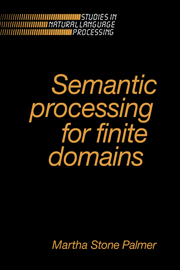5 - Results of inference-driven semantic analysis
Published online by Cambridge University Press: 24 November 2009
Summary
This chapter summarizes the results that have been presented in the preceding chapters, in particular the process by which inference-driven mapping goes directly from the syntactic parse of a sentence to a “deep” semantic representation that corresponds to a traditional linguistic decomposition. The summary illustrates two of the most important benefits offered by inference-driven mapping over the template approach, namely, (1) the clear distinction between the verb definition and the final semantic representation achieved, and (2) an integrated approach to semantic analysis. The first benefit is of special relevance to linguistic theories about semantic representations, in that it provides a testing ground for such theories. The second benefit is of more relevance to computational models of natural language processors, in terms of interfacing semantic processing with syntactic parsing. The last section suggests directions of future research for pursuing these objectives.
Integrated semantic analysis
As discussed in chapter 2, traditional approaches to semantic processing need several levels of description to produce a “deep” semantic representation from a syntactic parse. The most popular of these approaches, termed the template approach, can be seen as using at least two intermediate levels of description, (1) the template level which is used for assigning mappings from syntactic constituents and semantic roles, and (2) the canonical level where the semantic roles are grouped together to simplify derivation of a “deep” semantic representation. These separate levels of description impose several stages of processing on the implementations, since only certain pieces of information are available at any one stage.
- Type
- Chapter
- Information
- Semantic Processing for Finite Domains , pp. 148 - 173Publisher: Cambridge University PressPrint publication year: 1990



